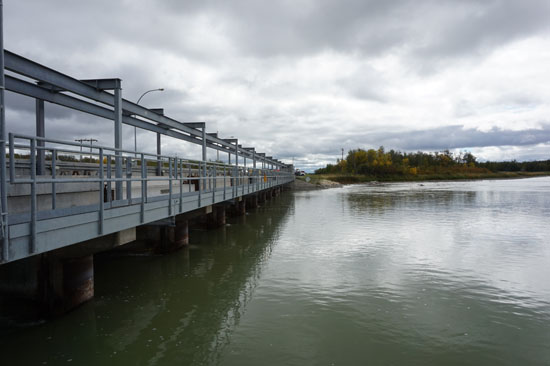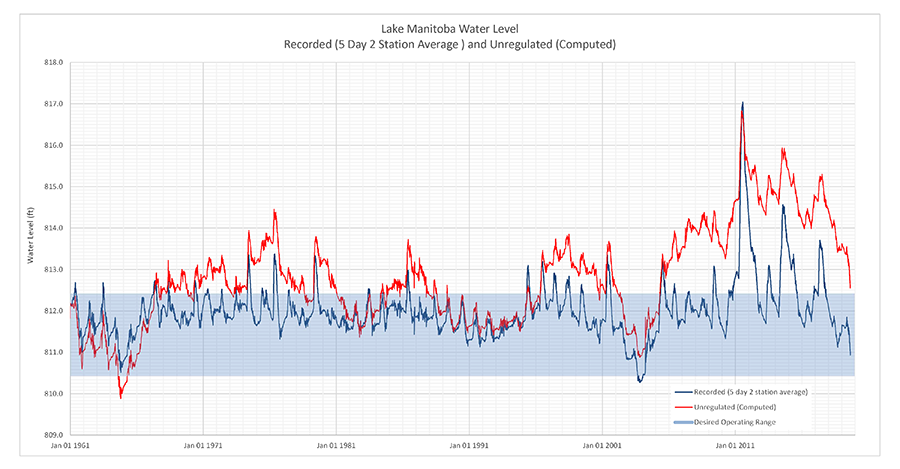Fairford River Water Control Structure
Background and Description
The Fairford River Water Control Structure is an outlet located on the Fairford River between Lake Manitoba and Lake St. Martin. It serves to regulate water levels on Lake Manitoba. Construction of the FRWCS began in 1959, with the structure becoming operational in 1961.
The Fairford River Water Control Structure consists of:
- An excavated channel - used to increase the capacity of the Fairford River
- 11 stop log bays - used to adjust the flow rate of the Fairford River
Flow through the Fairford River Water Control Structure is influenced by several factors, including lake level, wind direction, stop log setting, ice conditions and flow conditions.

Fairford River Water Control Structure
Operating Guidelines
The Lake Manitoba and Lake St. Martin regulation guidelines for the Fairford River Water Control Structure that were recommended by the 2003 Lake Manitoba Regulation Review Advisory Committee and later amended by the 2013 Lake Manitoba, Lake St. Martin Regulation Review Committee are as follows:
- The desired regulation range on Lake Manitoba is 812.5 feet (ft) to 810.5 ft. The desired regulation range on Lake St. Martin is 797.0 ft to 800.0 ft.
- During recovery from flood conditions on Lake Manitoba, the Fairford River Water Control Structure is kept wide open until Lake Manitoba recedes to the middle of the desired regulation range after which it should be cut back to achieve normal (natural) outflow (50-60% capacity)
- During recovery from drought, the Fairford River Water Control Structure is kept at 800 cubic feet per second (cfs) until Lake Manitoba levels increase to middle of the desired regulation range after which point the structure will be operated to achieve normal outflow (50-60% capacity)
- Under normal operating conditions, once outflow reaches normal, there are no further stop-log adjustments, as long as Lake Manitoba remains within the desired regulation range.
- Any variances in the lake levels outside of the desired regulation range shall be shared between Lake Manitoba and Lake St. Martin insofar as this may be reasonably possible.
- The minimum flow on the Fairford River should be 800 cfs with a desirable minimum flow of 1,000 cfs as often as possible.
Operational Information
Links to hydrographs from the Manitoba Infrastructure Hydrologic Forecast Centre
- Waterhen River Flows (PDF)
- Fairford River Flows (PDF)
- Dauphin River Flows (PDF)
- Lake Manitoba Water Levels (PDF)
- Lake St. Martin Water Levels (PDF)
Links to real-time data (Water Survey of Canada real-time gauges)
- Lake Manitoba at Steep Rock
- Lake Manitoba at Westbourne
- Fairford River near Fairford
- Lake St. Martin near Hilbre
- Dauphin River near Dauphin River
- Waterhen river near Waterhen
- Lake Winnipegosis at Winnipegosis
- Whitemud River at Westbourne
- Portage Diversion near Portage La Prairie
Stop Log Record
The Fairford River Water Control Structure controls the rate of outflow from Lake Manitoba through the addition and removal of stop logs. When the level of Lake Manitoba is low, logs are added to the control structure bays, reducing the size of the openings available for flow, and reducing discharge. When the level of Lake Manitoba is high, logs are removed from the bays, increasing the size of the openings available for flow, and increasing discharge.
The linked table below contains the detailed operation of the Fairford River Water Control Structure’s stop logs over the last several years. For each operation, the number of logs added or removed is indicated, along with the resulting number of logs in each bay.
- Stop Log Record (PDF 439 KB)
Lake Manitoba - Natural water levels vs. recorded water levels



